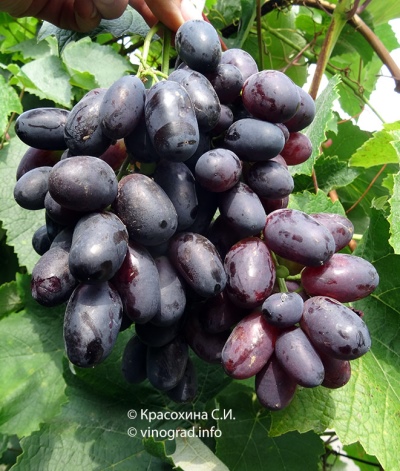
- Authors: Ivan Todorov, Bulgaria
- Appointment: dining room
- Berry color: dark red to deep purple
- Taste: harmonious
- With bones: Yes
- Ripening period: early
- Ripening period, days: 132
- Frost resistance, ° C: -22
- Bunch weight, g: 595
- Yield: 9.8 kg per bush, 350 kg / ha
Bulgarian grape varieties, one of which is Velika, are distinguished by their high yields and amaze with such qualities as the taste and size of the berries. But, unfortunately, due to the difference in climatic conditions, not all varieties take root in our country. The derived form, which will be discussed further, is just such a pleasant exception.
Breeding history
The author of this variety was the national breeder Ivan Todorov. In 1987, he crossed the French form Alphonse Lavallee and the Lebanese grape Karaburna (Bolgar). Both of them belong to the dining line and are very large.
10 years after the relevant tests, Velika was entered into the State Register of Breeding Achievements of Bulgaria. The name of this variety is telling, since the size of the brushes is really impressive.
Description
For its unique characteristics, Velika grapes are valued by amateur winegrowers in many countries. We are talking about both Bulgaria itself and countries that have similar climatic conditions.
Ripening period
In the conditions of Bulgaria, the country where the form was first developed and tested, Velika ripens at the end of August. It belongs to mid-early grape varieties, the ripening period of which is within 120-135 days. Depending on the number of sunny days in the season and other factors, the ripening time may shift in one direction or another.
Bunches
The grapes ripen on large, elongated clusters measuring 20 cm by 15 cm. The brush cannot be called dense, rather loose. Its weight ranges from 500 g to 1.5 kg. When properly formed, large clusters prevail on the bush. This grape variety has excellent commercial qualities.
Berries
The biggest advantage of Velika grapes is its berries. They are very large, up to 4 cm long, even. The shape of the berries is cylindrical, elongated, sometimes a slightly pointed tip is visible. On average, the weight of one berry is 13-14 g. The color of the grapes immediately attracts attention: burgundy-blue berries with a purple tint and a thin layer of natural wax bloom.
The pulp is crispy, firm, not watery, pink in color. The skin is elastic, protects the berries from cracking, wasps and adverse weather conditions. Velika has small seeds, which also has a positive effect on the taste.
Taste
The taste of the Velika variety is sweet, but not cloying, with a slight aftertaste of ripe cherries. Many table varieties are inferior in taste to these grapes. In 2012 and 2015, he took 1st place at the "Sunny Bunch" festival, and in 2013 - 2nd place.
The acidity of the berries is 5 grams per liter, sugar accumulation is 17% (or slightly lower, depending on the weather).
Yield
The Velika variety has excellent yield potential. The amount of berries harvested depends on several factors: climatic and weather conditions, protection against diseases, watering and general care. If the main agrotechnical measures are not carried out on time, then this affects the quantity and quality of the crop.
The benchmark is the yield achieved by winegrowers in Bulgaria - up to 10 kg per bush or 350 centners per hectare. In the conditions of Russia and Ukraine, the indicators may be lower.


Growing features
In order to get a good harvest every year, Velika needs competent care throughout the growing season. Its feature is the manifestation of the transgressive effect. This phenomenon is extremely rare and means an increased manifestation of some parental traits.
A characteristic feature of the Velika variety is the powerful growth of the bushes, which immediately attracts attention. Because of this, this grape needs to be shaped from the first year of life. And also because of the strong and tall shoots, they often do not normalize the future harvest.
Landing
Seedlings are obtained in various ways. First of all, this is vaccination. The varieties that can hold back the powerful growth of Veliki shoots (Chasla, Berlandieri) are not used as rootstocks. The best rootstocks are Monticola, CO4, 41B. Green cuttings are grafted into the cleft at a height of at least 50 cm.
Another way to obtain planting material is to plant pre-cut cuttings. Own-rooted seedlings are more resistant to diseases, but begin to bear fruit later than grafted ones.

Pollination
Velika is a self-pollinated variety. In rainy and inclement weather, the process can be a little delayed, so experienced growers use artificial pollination under unfavorable climatic conditions.
Pruning
The first pruning of Velika grapes should be done a couple of months after planting due to its strong growth. Only shoots close to the soil surface are left. Then they leave 3 or 4 ovaries on each shoot so that the vine does not crack under the weight of the bunches. For the convenience of care and collection of berries, a trellis is constructed.



Frost resistance and the need for shelter
The Velika variety is thermophilic, and therefore needs an obligatory shelter for the winter. The frost resistance of this grape is 22 degrees below zero.

Diseases and pests
Resistance to the main diseases of grapes is assessed by Velika at 4 points. Its advantage is that the variety is practically not affected by gray rot. Other diseases, such as mildew and oidium, are poorly resisted by grapes.

If a grape is exposed to any disease or insect, this always affects its appearance.
Storage
This grape variety can be stored in the refrigerator for a long time. Its transportability is unique, the bunches are not damaged when transported over long distances.











































































